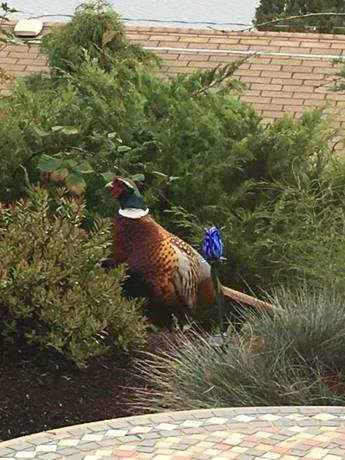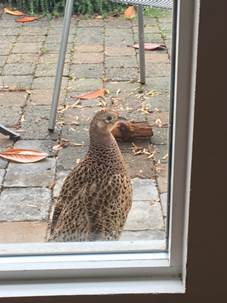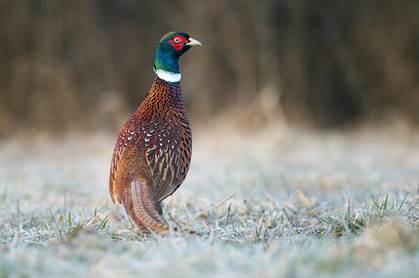See! from the brake the whirring pheasant springs, And mounts exulting on triumphant wings: Short is his joy; he feels the fiery wound, Flutters in blood, and panting beats the ground. Alexander Pope, Windsor Forest.
This is a bird native to Asia that has been widely introduced throughout the word for hunting. It is a familiar bird in the U.S., often seen scrambling across the road in rural areas. It is generally known as the common pheasant and goes by ringneck pheasant in the U.S., emphasizing the white ring around its neck.
The male is a quite striking bird and the color varies widely with the range of captive breeding and hybridization among subspecies. Most commonly in the U.S. the males are a bright gold with barring or copper-red and chestnut brouwn with an irredescence of green and purple. The head is green with a small crest and a distinctive red wattle. Two feathered ear tuffs give it a quizzical look and a long black tail adds to the regal look. An average male weighs about 2.5 pounds but they can get over 6 pounds. The females are slightly smaller and a rather bland universal light brown – all the better to blend in with vegetation while tending the nest.
This bird is thought to have been introduced into Great Britain in 1059 and introduced in North America in 1881 and is well established in the north east, mid-west, throughout the Rockies and south to Texas and then along the west coast. The Latin genus Phasianus comes from the Latin word for pheasant – phasianus and the species name colchicus refers to Colchis, a county on the Black Sea where Europeans reportedly became familiar with the bird. So important to hunters in the U.S., it is the state bird of South Dakota – only one of three non-native birds to have such a state honor.
The birds don’t spend much time on a ground nest – scraping out a site and throwing a few leaves and twigs together, typically under some dense cover. Males are polygynous – often acquiring a harem of several females. The clutch size varies from 8 to up to 18 eggs that hatch in 24 days or so. Chicks stay near the hen for several weeks and will subsist on insects early in life as they need the additional protein for growing. Later they will incorporate seeds, fruit, grain, and leaves into their diet. Small vertebrates such as mice, voles, and lizards will sometimes be taken. The birds have a distinctive call that can be heard echoing across farm fields Pheasant Call
When I was working as a fish biologist we had some local who maintained the boats, motor, and trucks. One of them had a buddy who ran a game farm – raising pheasant, chuckar, and quail that he supplied to private game farms and the state fish and game agencies. Once in a while he would score some pheasant eggs and put them in a large glass jar for pickling and then be kind enough to share them at lunch. Pretty good.
Once while we were driving back from a day on the Susquehanna River along a series of farm roads, a male pheasant darted out in the road and was struck by a car in front of us. Naturally we pulled over. We inspected it – it looked pretty good! One of my friends motto was – “Well, if you can’t tell if it’s bad or not, what’s the difference?” We threw it in the back of the truck and took it home. I skinned it and we had it for dinner, which proved the best dinner that week. But among five 20-something males maybe that wasn’t saying much.
I had carefully taken off the skin with the idea of stuffing it. But rather than spending money on the fancy wires and packing material I used what was around the house including some coat hangers. The result was somewhat less than elegant and a disservice to John J. Audubon. It had out-stretched neck with one ear tuft perpendicular to his head that gave him a jaunty/quizzical, rather Frankestein-ish quality to it for a small bird. The farm dog next door evidently thought so too as he would regularly come by the ground floor window where it was perched and bark at it insentiently.
Chris in our office took these photos of curious birds outside of his house:


